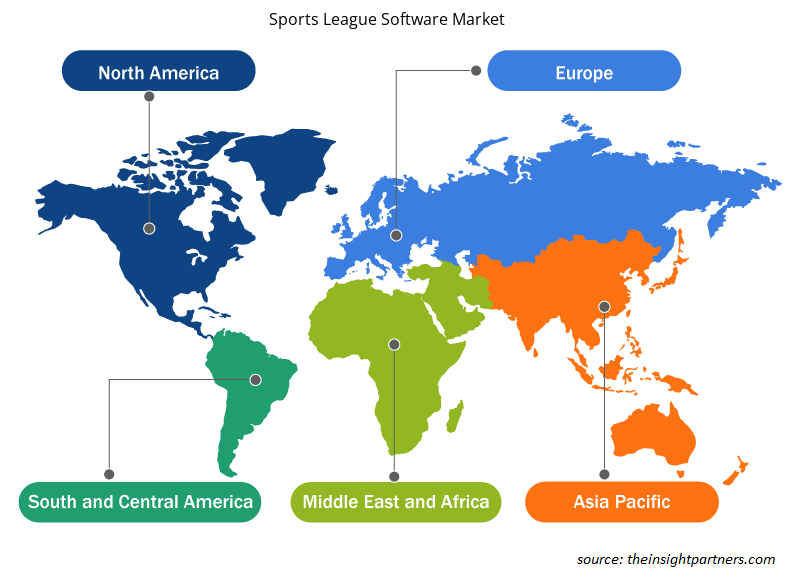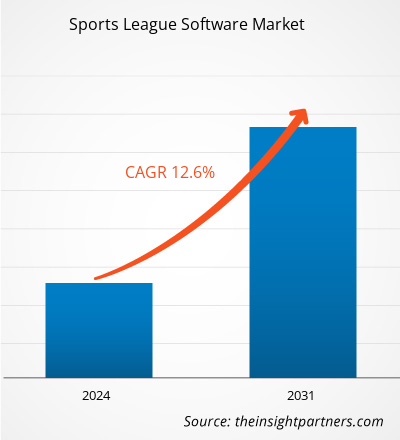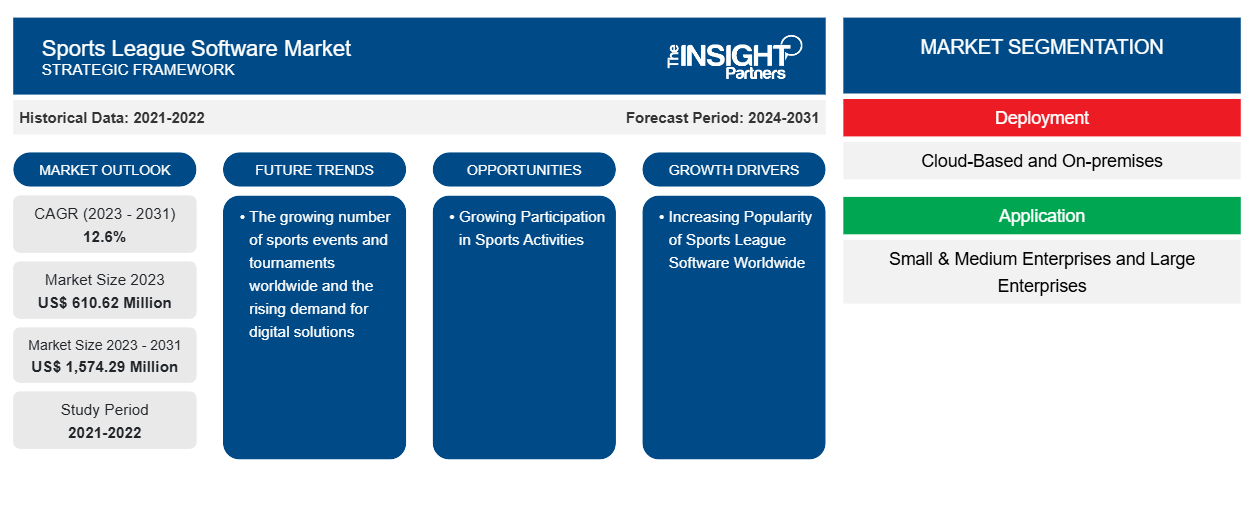Der Markt für Sportliga-Software soll von 610,62 Millionen US-Dollar im Jahr 2023 auf 1.574,29 Millionen US-Dollar im Jahr 2031 anwachsen. Der Markt soll zwischen 2023 und 2031 eine durchschnittliche jährliche Wachstumsrate (CAGR) von 12,6 % verzeichnen. Die wachsende Zahl von Sportveranstaltungen und Turnieren weltweit und die steigende Nachfrage nach digitalen Lösungen dürften weiterhin ein wichtiger Trend auf dem Markt für Sportliga-Software bleiben.
Analyse des Softwaremarktes für Sportligen
Der Markt für Sportliga-Software wächst rasant, da diese weltweit immer beliebter wird und die Nachfrage nach Fan-Engagement über physische Events hinaus steigt. Der Markt wächst stetig, angetrieben durch die steigende Popularität von Online-Sportspielen und die zunehmende Präferenz für mobilfunkbasierte Sportliga-Software. Darüber hinaus bieten steigende Investitionen in die Entwicklung der Technologieinfrastruktur und die wachsende Teilnahme an Sportaktivitäten lukrative Möglichkeiten für Marktwachstum.
Überblick über den Markt für Sportliga-Software
Mit der Software für Sportligen können Sportadministratoren und -organisatoren Veranstaltungen planen , Einrichtungen verwalten, die Veranstaltungsregistrierung automatisieren und Spielerdaten und Teamzuweisungen verfolgen. Die Software ist mit leistungsstarken Algorithmen und verschiedenen Schnittstellen ausgestattet, die eine effiziente Datenanalyse ermöglichen und Erkenntnisse liefern, die zur Leistungsverbesserung und strategischen Planung beitragen. Normalerweise läuft die Software auf Cloud-basierten Plattformen, einige Versionen unterstützen jedoch auch die Installation vor Ort. Die Software bietet Benutzern die Vorteile der Überwachung und Steuerung vieler Elemente des Sportbetriebs mit minimalem manuellen Aufwand. Sie bietet benutzerfreundliche Dashboards und angepasste Module, die die Verwaltungsarbeit rationalisieren und die Ressourcenzuweisung optimieren. Die wachsenden Investitionen von Bildungseinrichtungen in Sportaktivitäten schaffen jedoch Chancen für das Marktwachstum.
Passen Sie diesen Bericht Ihren Anforderungen an
Sie erhalten kostenlos individuelle Anpassungen an jedem Bericht, einschließlich Teilen dieses Berichts oder einer Analyse auf Länderebene, eines Excel-Datenpakets sowie tolle Angebote und Rabatte für Start-ups und Universitäten.
-
Holen Sie sich die wichtigsten Markttrends aus diesem Bericht.Dieses KOSTENLOSE Beispiel umfasst eine Datenanalyse von Markttrends bis hin zu Schätzungen und Prognosen.
Treiber und Chancen auf dem Sportliga-Softwaremarkt
Die weltweit zunehmende Popularität von Sportliga-Software treibt den Markt an
Steigende Nachfrage nach Cloud-basierter Sportliga-Software aufgrund des wachsenden Bewusstseins für das Potenzial von Cloud Computing in der Sportbranche. Die Branche sieht den Wert von Cloud Computing darin, rationalisiertere und effektivere Abläufe zu ermöglichen. Cloud-basierte Sportliga-Software ermöglicht es Unternehmen, ihre Sportaktivitäten von überall aus zu verwalten, mit den zusätzlichen Vorteilen von Skalierbarkeit und Kosteneffizienz. Darüber hinaus macht die Sportliga-Software die menschliche Dateneingabe überflüssig, was zu höherer Datengenauigkeit und schnellerer Entscheidungsfindung führt. Diese Faktoren werden voraussichtlich den Markt im Prognosezeitraum antreiben.
Wachsende Teilnahme an sportlichen Aktivitäten – eine Chance auf dem Markt für Sportliga-Software
Eine steigende Zahl an Sportteilnehmern, verbunden mit der wachsenden Zahl an Profisportlern und der steigenden Popularität von Online-Sportspielen, treibt den Markt weltweit an. Dies erhöht die Nachfrage nach Sportliga-Software bei Unternehmen, um ihre Abläufe effektiv zu verwalten und die Rentabilität zu maximieren. Darüber hinaus hat die Verbreitung mobiler Geräte es Sportlern und Sportteams ermöglicht, unterwegs auf Sportliga-Software zuzugreifen, was die Betriebseffizienz steigert. Diese Faktoren schaffen also in naher Zukunft erhebliche Wachstumschancen für den Markt.participations in sports associated with the expanding number of professional athletes and the rising popularity of online sports gaming is driving the market around the world. This increases the demand for sports league software among businesses to effectively manage their operations to maximize profitability. Furthermore, the growth of mobile devices has allowed athletes and sports teams to access sports league software while on the go, hence enhancing operational efficiency. Thus, these factors are creating significant growth opportunities for the market in the near future.
Segmentierungsanalyse des Marktberichts für Sportliga-Software
Wichtige Segmente, die zur Ableitung der Marktanalyse für Sportliga-Software beigetragen haben, sind Bereitstellung und Anwendung.
- Basierend auf der Bereitstellung ist der Markt für Sportliga-Software in Cloud-basierte und On-Premise-Systeme unterteilt. Das Segment der Cloud-basierten Systeme hatte im Jahr 2023 einen größeren Marktanteil.
- In Bezug auf die Anwendung wird der Markt in kleine und mittlere Unternehmen sowie in große Unternehmen unterteilt. Das Segment der großen Unternehmen hatte im Jahr 2023 einen größeren Marktanteil.
Marktanteilsanalyse für Sportliga-Software nach geografischer Lage
Der geografische Umfang des Marktberichts für Sportliga-Software ist hauptsächlich in fünf Regionen unterteilt: Nordamerika, Asien-Pazifik, Europa, Naher Osten und Afrika sowie Südamerika/Süd- und Mittelamerika.
In Bezug auf den Umsatz hatte Nordamerika den größten Marktanteil im Bereich der Sportliga-Software, was auf die steigende Zahl der Sportteams und den wachsenden Bedarf an kostengünstigen Lösungen für die effiziente Verwaltung von Sportaktivitäten zurückzuführen ist. Es wird erwartet, dass der Markt in naher Zukunft wachsen wird, was auf technologische Fortschritte und die zunehmende Verbreitung von Cloud-basierten Lösungen zurückzuführen ist. Diese Lösungen bieten den Benutzern erhebliche Vorteile, darunter Flexibilität, Skalierbarkeit und Kosteneffizienz, die Sportteams und -organisationen anziehen. Darüber hinaus beflügelt eine zunehmende Zahl von Sportveranstaltungen und Turnieren den Markt im Prognosezeitraum.
Regionale Einblicke in den Markt für Sportliga-Software
Die regionalen Trends und Faktoren, die den Markt für Sportliga-Software im Prognosezeitraum beeinflussen, wurden von den Analysten von Insight Partners ausführlich erläutert. In diesem Abschnitt werden auch die Marktsegmente und die Geografie des Marktes für Sportliga-Software in Nordamerika, Europa, im asiatisch-pazifischen Raum, im Nahen Osten und Afrika sowie in Süd- und Mittelamerika erörtert.

- Erhalten Sie regionale Daten zum Markt für Sportliga-Software
Umfang des Marktberichts zur Sportliga-Software
| Berichtsattribut | Details |
|---|---|
| Marktgröße im Jahr 2023 | 610,62 Millionen US-Dollar |
| Marktgröße bis 2031 | 1.574,29 Millionen US-Dollar |
| Globale CAGR (2023 - 2031) | 12,6 % |
| Historische Daten | 2021-2022 |
| Prognosezeitraum | 2024–2031 |
| Abgedeckte Segmente |
Nach Bereitstellung
|
| Abgedeckte Regionen und Länder |
Nordamerika
|
| Marktführer und wichtige Unternehmensprofile |
|
Dichte der Akteure auf dem Markt für Sportliga-Software: Die Auswirkungen auf die Geschäftsdynamik verstehen
Der Markt für Sportliga-Software wächst rasant, angetrieben durch die steigende Nachfrage der Endnutzer aufgrund von Faktoren wie sich entwickelnden Verbraucherpräferenzen, technologischen Fortschritten und einem größeren Bewusstsein für die Vorteile des Produkts. Mit steigender Nachfrage erweitern Unternehmen ihr Angebot, entwickeln Innovationen, um die Bedürfnisse der Verbraucher zu erfüllen, und nutzen neue Trends, was das Marktwachstum weiter ankurbelt.
Die Marktteilnehmerdichte bezieht sich auf die Verteilung der Firmen oder Unternehmen, die in einem bestimmten Markt oder einer bestimmten Branche tätig sind. Sie gibt an, wie viele Wettbewerber (Marktteilnehmer) in einem bestimmten Marktraum im Verhältnis zu seiner Größe oder seinem gesamten Marktwert präsent sind.
Die wichtigsten auf dem Markt für Sportliga-Software tätigen Unternehmen sind:
- ACTIVE Network, LLC
- Engage Sports, LLC
- EZ-Einrichtung
- Jersey-Uhr
- LigaRepublik
- PlayyOn, Inc.
Haftungsausschluss : Die oben aufgeführten Unternehmen sind nicht in einer bestimmten Reihenfolge aufgeführt.

- Überblick über die wichtigsten Akteure auf dem Sportliga-Softwaremarkt
Neuigkeiten und aktuelle Entwicklungen zum Sportliga-Softwaremarkt
Der Markt für Sportliga-Software wird durch die Erfassung qualitativer und quantitativer Daten nach Primär- und Sekundärforschung bewertet, die wichtige Unternehmensveröffentlichungen, Verbandsdaten und Datenbanken umfasst. Im Folgenden finden Sie eine Liste der Entwicklungen auf dem Markt für Sportliga-Software und -Strategien:
- Im Januar 2023 nahm Jonas Club Software an der PGA Show 2023 teil, die vom 24. bis 27. Januar 2023 in Orlando, Florida, stattfand. Das Unternehmen präsentierte seine neuesten innovativen Produkte und Software, darunter eine exklusive Vorschau der komplett neu gestalteten ClubHouse Online Mobile App am Stand Nr. 3929 und anderer Sportmanagement-Software. (Quelle: Jonas Club Software, Pressemitteilung, 2023)
Marktbericht zu Sportliga-Software – Abdeckung und Ergebnisse
Der Bericht „Marktgröße und Prognose für Sportliga-Software (2021–2031)“ bietet eine detaillierte Analyse des Marktes, die die folgenden Bereiche abdeckt:
- Marktgröße und Prognose auf globaler, regionaler und Länderebene für alle wichtigen Marktsegmente, die im Rahmen des Projekts abgedeckt sind
- Marktdynamik wie Treiber, Beschränkungen und wichtige Chancen
- Wichtige Zukunftstrends
- Detaillierte PEST/Porters Five Forces- und SWOT-Analyse
- Globale und regionale Marktanalyse mit wichtigen Markttrends, wichtigen Akteuren, Vorschriften und aktuellen Marktentwicklungen
- Branchenlandschaft und Wettbewerbsanalyse, einschließlich Marktkonzentration, Heatmap-Analyse, prominenten Akteuren und aktuellen Entwicklungen
- Detaillierte Firmenprofile
- Historische Analyse (2 Jahre), Basisjahr, Prognose (7 Jahre) mit CAGR
- PEST- und SWOT-Analyse
- Marktgröße Wert/Volumen – Global, Regional, Land
- Branchen- und Wettbewerbslandschaft
- Excel-Datensatz
Aktuelle Berichte
Verwandte Berichte
Erfahrungsberichte
Grund zum Kauf
- Fundierte Entscheidungsfindung
- Marktdynamik verstehen
- Wettbewerbsanalyse
- Kundeneinblicke
- Marktprognosen
- Risikominimierung
- Strategische Planung
- Investitionsbegründung
- Identifizierung neuer Märkte
- Verbesserung von Marketingstrategien
- Steigerung der Betriebseffizienz
- Anpassung an regulatorische Trends























 Kostenlose Probe anfordern für - Markt für Sportliga-Software
Kostenlose Probe anfordern für - Markt für Sportliga-Software